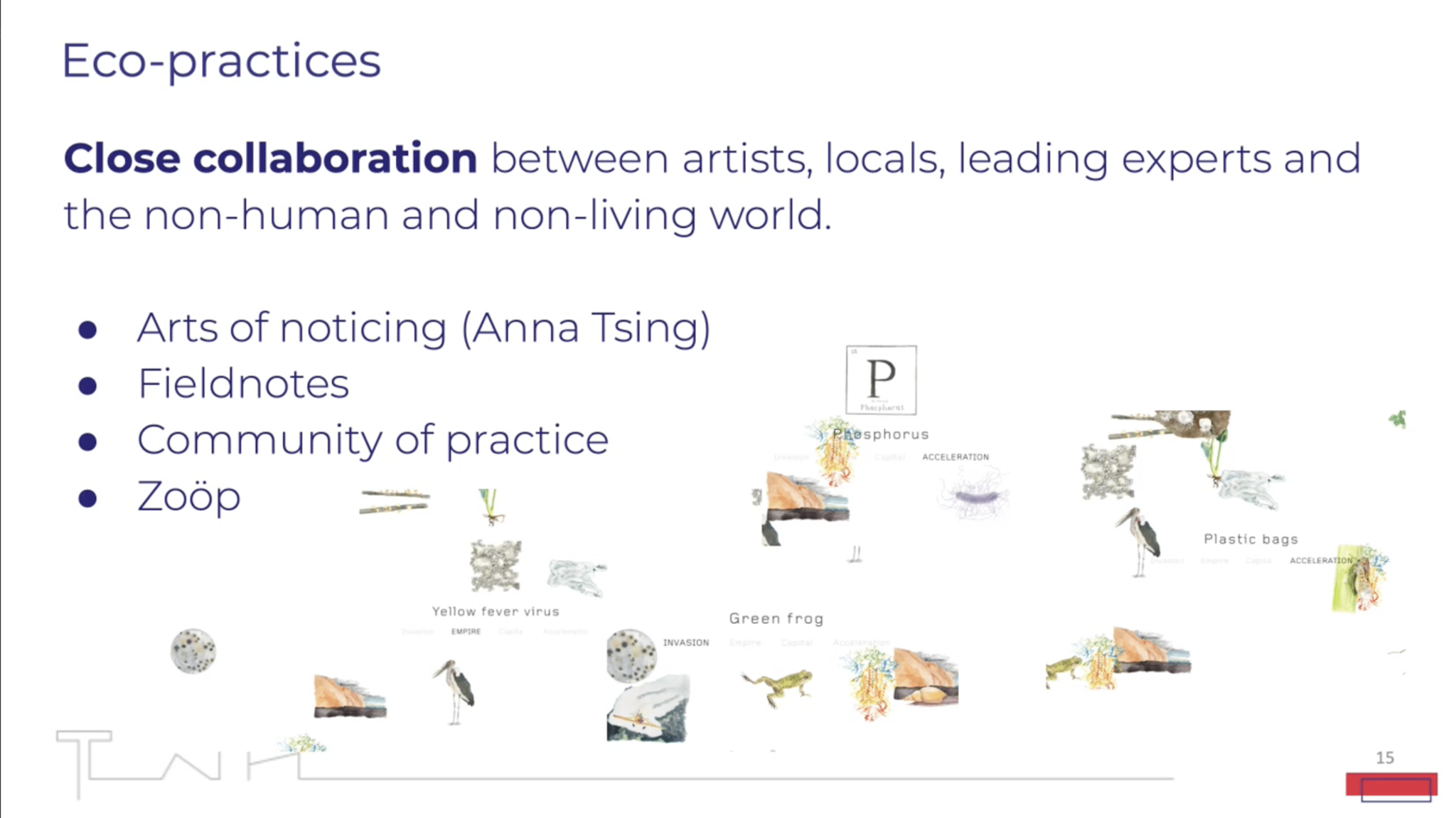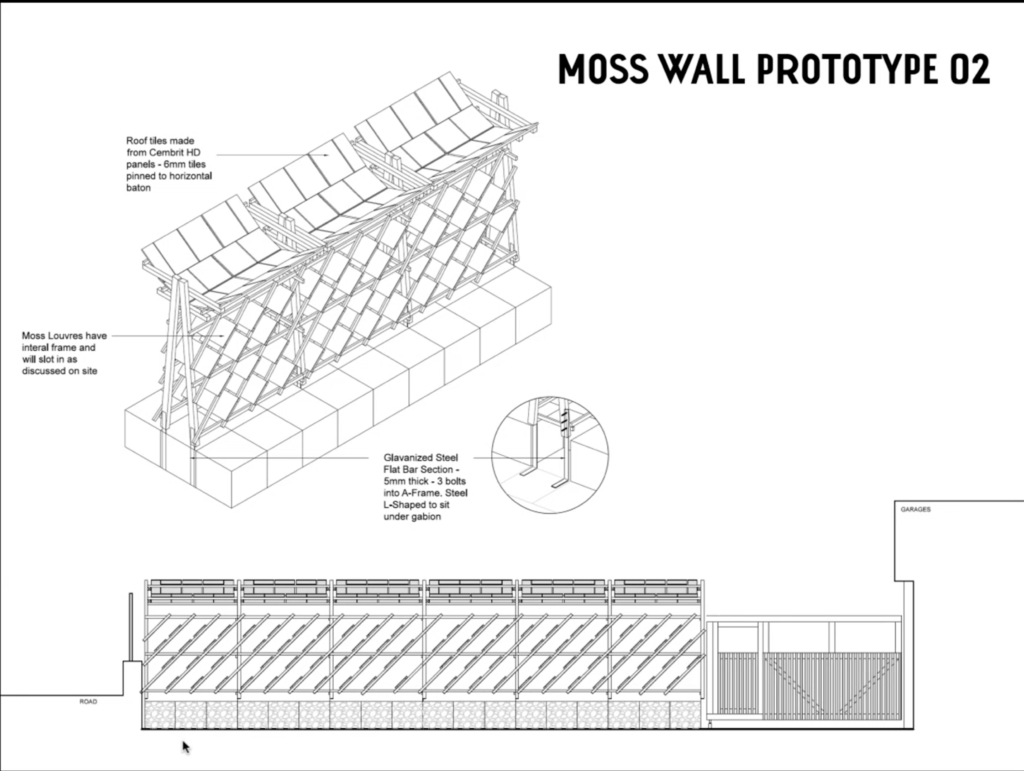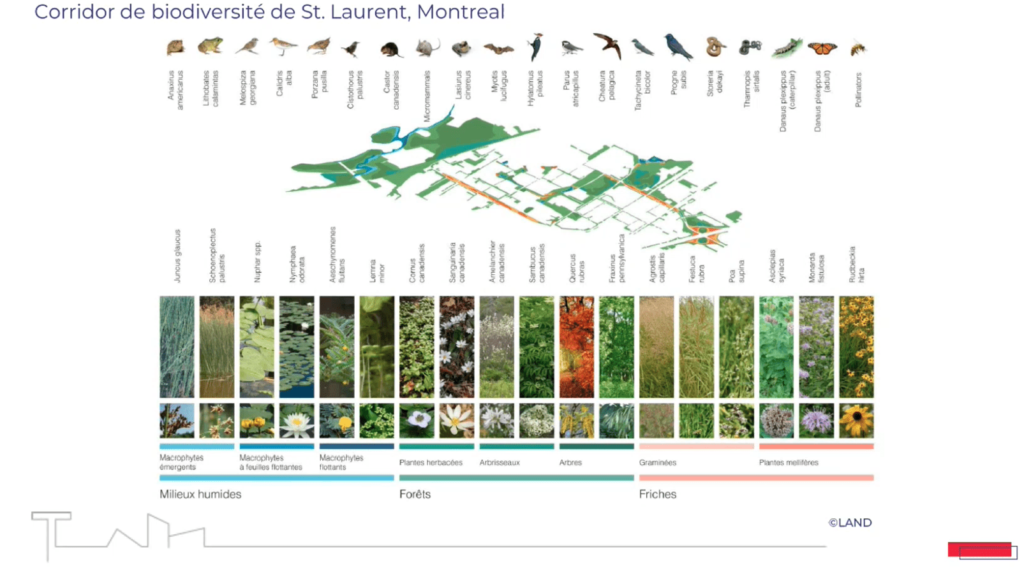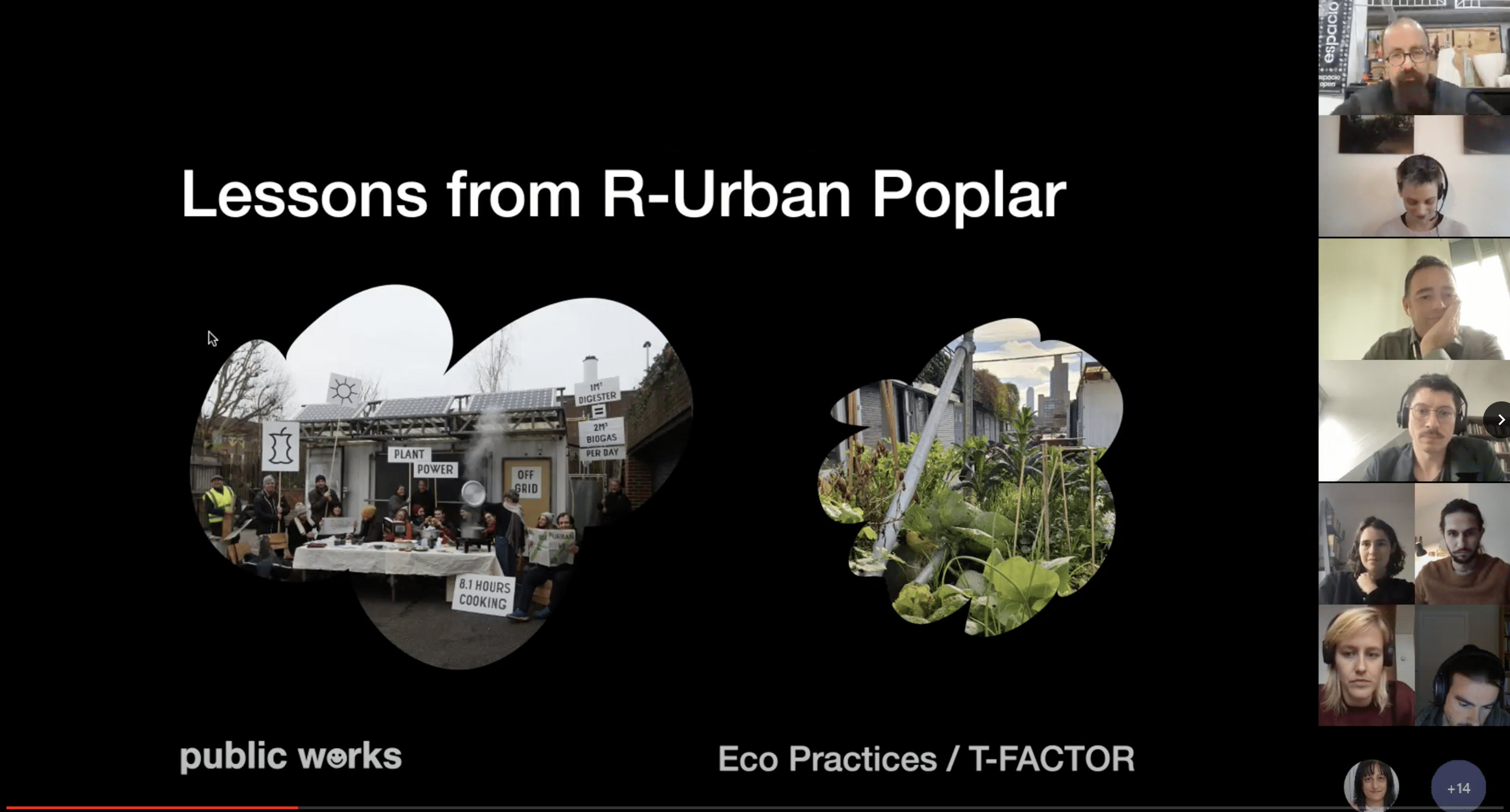In 2021 the T-Factor Transformation Labs (T-Labs) organised experimental activities, called T-Probes. They act as prototypes to open the pilot cities to new ways of thinking and test new approaches.
T-Lab 1’s probe, focussed on Arts, Culture and Creativity, explores how communities of practice can be convened and mobilised to address challenges with new approaches. A community of practice can be formed by practitioners from a higher education institute, a grassroots organisation or citizens from a local community.
Through T-Lab 1 a range of cutting-edge eco-practices across the T-Factor consortium was identified and materialised through activities and the established ecologies of the pilots. The Probe put together a round table event in November 2021 to share this expertise, between these different actors, as a community of practice, and with a wider public.
The presentations were composed of practitioners from Amsterdam, Barcelona, London and Milan and addressed the shifting relationship between nature and urban transformation. The event stimulated a conversation between the four represented cities, with questions from the audience.
The themes and personnel of the presentations were:
Session 1 – Urban Ecology – moderated by Karim Asry
- Rosalie Bak (Amsterdam – Waag), New approaches to Urban Ecology: the Amsterdam Science Park case
- Andrew Belfield (London, Public Works), Eco-Civic prototyping: lessons from R-Urban Poplar
Session 2 – Nature Based Solutions – moderated by Besnik Mehmeti
- Isabel Ruiz-Mallén (Barcelona, Urban Transformation and Global Change lab Universitat Oberta de Catalunya), The transformative capacities of bottom-up climate resilience strategies
- Andrea Balestrini (Milan, LAND), From spaces to places: participative approaches as starters towards ecologically sound landscape projects
What follows is a synopsis of the presentations and the key points from the discussions. For reference, the videos of Session 1 and Session 2 are available online.
Session 1 :
New approaches to Urban Ecology: the Amsterdam Science Park case
Rosalie Bak (Amsterdam – Waag)

Amsterdam Science Park is connected to green pathways into Amsterdam city. The methodology of this case study is expressed as a movement from co-practice to co-planning, leading to co-governance. The key question is ‘how can communities convene and mobilise new approaches?’
Urban ecology regards the city as a living space rather than as a built environment. It traces the entanglements of human and non-human forms of life. It focuses on cohabitation and mutual dependencies, raising questions of mutual care and wellbeing. This leads to the question of how to renew the relationship of nature in the urban environment. The goals of this approach are to introduce the ecology of non-human actors as active stakeholders in the development of the Amsterdam Science Park masterplan and to strengthen and enliven the social, economic and ecological fabric of the site with meanwhile activities, leading to permanent uses.
Eco practices are situated actions which are process based and community centric taking the form of embodied learning and active doing through co-creative and cartographic processes. Collaborations between artists, locals, leading experts and the non-human and non-living world are central to this process (for example, with the Arts of Noticing project led by the artist Anna Tsing). 4 examples of these collaborations were discussed; a co-creation walk, a co-imagining children’s workshop, a co-development stakeholder workshop and a co-cultivation wilderness workshop. All these activities entail situating the subject within the environment, toward developing an alternative masterplan, inclusive of a multiplicity of perspectives and narratives. The Zoop organisation was discussed. Zoop is a new legal framework for non-human voices in businesses. It offers an overarching governance structure whose board includes a representative for the voices and interests of non-human life so they can become an active part of organisational decision making.
Eco-Civic prototyping: lessons from R-Urban Poplar
Andrew Belfield (London, Public Works)

Eco-Civic Prototyping is a situated design practice that focuses on co-produced, bottom-up resilience, responding to local climatic challenges. Public Works is an Interdisciplinary design practice working between architecture, art and activism that aims to bring social and environmental change within cities. R-urban is a collaborative project between AAA in Paris and Public Works which supports alternative ways of urban and civic resilience through a series of eco-civic hubs.
The talk focused on the work that has taken place at Public Works’ Eco-civic hub in Poplar, London. The hub has developed incrementally and localises climate change questions in terms of co-produced bottom-up responses. The hub is constituted as a series of prototype infrastructures, testing a more resilient food system, improving air quality through green infrastructure and supporting the infrastructure toward the possibility of a more circular economy. Situated design practice responds to localised contexts, focusing on relational design practises, building networks of solidarity and knowledge within the hub. This knowledge is manifested through the prototypes the hub produces.
The Poplar hub works between different communities within the locality and the presentation focused upon the respective communities of place and concern. The hub also works between human actors from the communities of residents, schools and youth groups and the ‘more than human’ components such as the developing ecology of the site. The presentation detailed the examples of 2 prototypes; moss walls and circular food systems where Public Works act as a co-learner, focusing on what they don’t know to develop a response to a question. The question of scalability was discussed, how the circular food prototype can be scaled up to meet the needs of the 790 residents of a local housing estate.
Discussion: How to introduce “more than human” solutions
The key question how can stakeholders be convinced that the ‘more than human’ solutions can be scaled into being viable and sustainable solutions? opened the discussion. Constant iteration was something that linked the 2 presentations. Prototyping as a way of community building in terms of communities of place and concern was identified by Amsterdam as being of interest. The Poplar hub marks a step change in terms of developing solutions with the communities and iteratively.
In terms of scalability, London spoke of the need to talk to the different values represented by the prototyping from the perspective of local councils and funders. These values can be social as well as ecological. The question of how the proof of concept in terms of these ideas can be embodied into policy arose and was addressed by London from the perspective of how the Greater London Authority economically assesses projects such as theirs at the expense of social and ecological value. London was interested in Amsterdam’s aim to get such values embodied into governance through the Zoop structure. There was also great interest from the audience about Zoop and is something that needs further examination as a way of embodying social and ecological values into policy. Amsterdam expanded on how Zoop works and how its legal framework operates as a neutral governance model.
The question of the qualities of scalability arose, how something is scaled across a community and then across a city. London spoke of using network building and solidarity systems to facilitate this.
The talk focused on the work that has taken place at Public Works’ Eco-civic hub in Poplar, London. The hub has developed incrementally and localises climate change questions in terms of co-produced bottom-up responses. The hub is constituted as a series of prototype infrastructures, testing a more resilient food system, improving air quality through green infrastructure and supporting the infrastructure toward the possibility of a more circular economy. Situated design practice responds to localised contexts, focusing on relational design practises, building networks of solidarity and knowledge within the hub. This knowledge is manifested through the prototypes the hub produces.
The Poplar hub works between different communities within the locality and the presentation focused upon the respective communities of place and concern. The hub also works between human actors from the communities of residents, schools and youth groups and the ‘more than human’ components such as the developing ecology of the site. The presentation detailed the examples of 2 prototypes; moss walls and circular food systems where Public Works act as a co-learner, focusing on what they don’t know to develop a response to a question. The question of scalability was discussed, how the circular food prototype can be scaled up to meet the needs of the 790 residents of a local housing estate.
Session 2 :
The transformative capacities of bottom-up climate resilience strategies
Isabel Ruiz-Mallén (Barcelona, Urban Transformation and Global Change lab Universitat Oberta de Catalunya)

The presentation focused on how the concept of transformative urban governance operates, beyond top-down actions toward grassroot responses to environmental and climate change impact through community led, bottom-up resilience initiatives. In the current context of increasing citizen mobilisation to climate emergency, cities emerge as a critical arena for community climate resilience to flourish and take a stand. A series of examples of such bottom-up initiatives were presented. Rescities is a project taking place in Barcelona and Seville where initiatives were mapped, published and disseminated.
Can Masdeu is a self-managed, community-based initiative that promotes political and social awareness of the effects of climate change in Barcelona, developing 2 projects to tackle hydro-climatic risks. The first project is the restoration of a large raft of the Can Masdeu valley using approaches from forest hydrology, ecological restoration, bio-landscaping and permaculture to rehabilitate key infrastructure to store water in periods of drought and to reduce the impact of floods.
The second project is based in the Can Masdeu community gardens, a 2,800 m2 area distributed over more than 30 plots. It was opened in 2002 and cultivated mainly by older people from the Nou Barris community and gardeners from the Can Masdeu hub. The old agricultural farm terraces were recovered, they have the potential to contribute to resilience against floods, heat waves and droughts. The project is open to neighbouring communities and other interested parties and is supported by a rich international network of universities and research centres.
Another project focuses on urban and peri-urban self-managed community gardens where activities are decided collectively. Many of these projects claim public spaces and the right for the city to be green, for example, by squatting Barcelona’s many vacant lots. Barcelona City Council has invigorated unused land for meanwhile use for up to 3 years for public and private non-profit entities through the Pla Buits scheme that aims to bring social involvement into this aspect of land use. Organisations are invited to propose activities that foster public use value of these lots. The programme aims to avoid unwanted uses and social exclusion and seeks to involve a diverse range of stakeholders in urban regeneration. A good example of this is an inter-generational project in Sant Andreu.
The final project presented was a collective tree pit gardening scheme promoted by a non-profit workers co-operative which designs and manages community socio-environmental projects with the aim of re-naturalising the city. A diverse range of stakeholders are involved and share responsibility for the tree planting and maintenance. This addresses the major problem that the city does have the resources to maintain these pits. This project mobilises a volunteer network to look after them. This process improves rainwater retention in the subsoil, helping to reduce the volume of runoff and potential flood water.
The takeaway from this session was that community institutions are resilient to change and learn from challenges in response to stresses and shocks such as floods and that they can foster transformative change. Transformative change at a regional scale can be too costly or socially problematic. Local transformative change in a sequential way can lead to feedback effects that improve resilience at a level that benefits the whole system. The major challenges of community climate resilience are that the community is often difficult to define, and it is not an isolated entity; communities are not homogenous units, heterogeneity need considering when trying to understand community resilience. Power issues also exist within communities as well as conflicting interests that can lead to the failure of bottom-up initiatives.
From spaces to places: participative approaches as starters towards ecologically sound landscape projects
Andrea Balestrini (Milan, LAND)

The presentation started by highlighting the disconnect between people and nature and that this is the main driver that necessitates participative approaches in terms of nature-based solutions. This is against the background of increasing militation for environmental justice, especially amongst younger people. The EU has robustly applied its strategy for nature-based solutions since 2015 and in February 2021 this was in the form of the new European Climate Adaption Strategy. Land, as landscape architects, identify who is the inhabitant and who is the host within a project framed by the question, how can nature thrive alongside human activity? This was clear in the example of one of Land’s projects, a park which is a biodiversity corridor in Montreal that contains spaces for nature where humans are not permitted.
Land is leading one of T-Factor’s Transformation Labs, T-Lab 4, exploring the theme of Urban Design for Sociality and Wellbeing. In this context, T-Lab 4 has been running workshops with Pilot cities to explore and experiment with ideas toward the testing and implementation of temporary uses. This was carried out with the Milan and Amsterdam pilots by asking the question ‘how can our relationship with nature be renewed in the urban environment’. In 2021 exploratory events were organised with these pilots and their stakeholders to explore their contexts, leading to participatory events within the pilot sites.
One of these events was focused on alternative mappings. The methodology was in terms of preparing Sensemaking T-Probe cards on which there is a map of the area upon which a series of stations are defined along a trajectory within the site. These ‘stops’ were moments where a potential to investigate an aspect of the context was identified. Participants recorded their impressions of these moments. The data was then clustered, and each station was assigned a different character toward realising a specific potential. Some participants proposed actions, and the final stage of this process was the proposal level.
The presentation then showed how this was applied to the Mind Pilot in Milan. Land invited local stakeholders from the pilot, who they had got to know during the exploratory phase of the process. The aim was to look at certain questions such as the accessibility to the site which is a major issue and how the perception of the landscape changes according to the means of transport that are used. For example, exploring the site as a bike ride. Human and non-human perceptions were mapped, helping to redefine the perception of the site. From the data that was processed from the cards, clustering of topics and keywords around each stop were identified. This has led to the construction of a placemaking compass which is a way to visualise the data clustering from the previous phase. Here, keywords and emotions are mapped toward possible key actions in proximity to the different stops.
Can Masdeu is a self-managed, community-based initiative that promotes political and social awareness of the effects of climate change in Barcelona, developing 2 projects to tackle hydro-climatic risks. The first project is the restoration of a large raft of the Can Masdeu valley using approaches from forest hydrology, ecological restoration, bio-landscaping and permaculture to rehabilitate key infrastructure to store water in periods of drought and to reduce the impact of floods.
The second project is based in the Can Masdeu community gardens, a 2,800 m2 area distributed over more than 30 plots. It was opened in 2002 and cultivated mainly by older people from the Nou Barris community and gardeners from the Can Masdeu hub. The old agricultural farm terraces were recovered, they have the potential to contribute to resilience against floods, heat waves and droughts. The project is open to neighbouring communities and other interested parties and is supported by a rich international network of universities and research centres.
Another project focuses on urban and peri-urban self-managed community gardens where activities are decided collectively. Many of these projects claim public spaces and the right for the city to be green, for example, by squatting Barcelona’s many vacant lots. Barcelona City Council has invigorated unused land for meanwhile use for up to 3 years for public and private non-profit entities through the Pla Buits scheme that aims to bring social involvement into this aspect of land use. Organisations are invited to propose activities that foster public use value of these lots. The programme aims to avoid unwanted uses and social exclusion and seeks to involve a diverse range of stakeholders in urban regeneration. A good example of this is an inter-generational project in Sant Andreu.
The final project presented was a collective tree pit gardening scheme promoted by a non-profit workers co-operative which designs and manages community socio-environmental projects with the aim of re-naturalising the city. A diverse range of stakeholders are involved and share responsibility for the tree planting and maintenance. This addresses the major problem that the city does have the resources to maintain these pits. This project mobilises a volunteer network to look after them. This process improves rainwater retention in the subsoil, helping to reduce the volume of runoff and potential flood water.
The takeaway from this session was that community institutions are resilient to change and learn from challenges in response to stresses and shocks such as floods and that they can foster transformative change. Transformative change at a regional scale can be too costly or socially problematic. Local transformative change in a sequential way can lead to feedback effects that improve resilience at a level that benefits the whole system. The major challenges of community climate resilience are that the community is often difficult to define, and it is not an isolated entity; communities are not homogenous units, heterogeneity need considering when trying to understand community resilience. Power issues also exist within communities as well as conflicting interests that can lead to the failure of bottom-up initiatives.
Discussion
The perception that the city should be tidy and regimented in the face of projects such as the Barcelona tree pits which are sometimes viewed by residents as being ’messy’ was addressed. Often the tree pits are also simply seen as dog toilets, compounding this problem. In neighbourhoods where this was an issue there is an important need to communicate with what seems like very few citizens who have a strong voice. There is no easy solution to such resistance to urban transformation. This is also a challenge from the perspective of Land who suggested the best way to counter complaints of ‘mess’ is to communicate how and when a project is working well so that the benefits of negative perceptions can be countered.
There were also discussions about the need for nature-based solutions led by municipalities being maintained and that local action often is a solution. Inclusivity in participatory practises is an ongoing issue, where processes of levelling and collaboration must be continually reviewed.
KEY LEARNINGS
- Urban ecology regards the city as a living space rather than as a built environment. It traces the entanglements of human and non-human forms of life. It focuses on cohabitation and mutual dependencies, raising questions of mutual care and wellbeing.
- Situated design practice responds to localised contexts, focusing on relational design practises, building networks of solidarity and knowledge within a hub. This knowledge is manifested through the prototypes that a hub produces.
- The concept of transformative urban governance operates beyond top-down actions toward grass roots responses to environmental and climate change impact through community led, bottom-up resilience initiatives. In the current context of increasing citizen mobilisation to climate emergency, cities emerge as a critical arena for community climate resilience to flourish and take a stand.
Participative approaches identify who is the inhabitant and who is the host within a site, framed by the question, how can nature thrive alongside human activity? The activity of data collection can be considered both as a preparatory activity for the future development of a project but above all it can be the basis for a new knowledge of the place and its future vocations.
